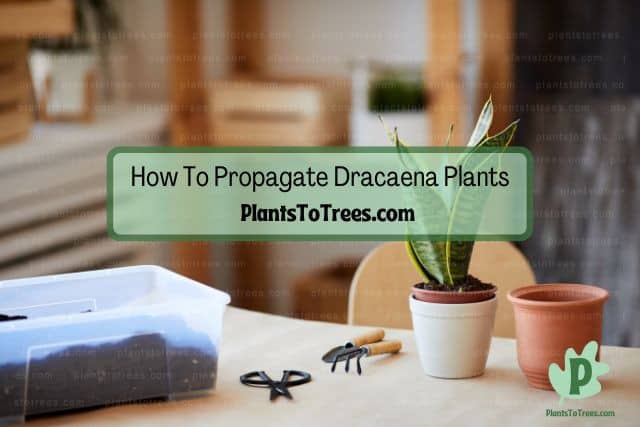Grown for its attractive foliage, the dracaena plant is a low-maintenance houseplant that is native to Africa, southern Asia, and northern Australia. The dracaena plant isn’t too picky, and can even tolerate low light conditions, which makes it an ideal houseplant if you don’t have a lot of bright areas in your home. With that said, however, following a dracaena plant care guide will help keep the houseplant healthy for years to come.

Dracaena plants have few requirements, but will need to be kept indoors in areas where the temperature drops below 65 degrees. You will also need to ensure they are kept out of direct sunlight and watered when the first few inches of soil starts to feel dry.
Dracaena plants thrive in bright indirect sunlight, but they can tolerate some low light conditions. Just be warned that lower light means the plant won’t grow as quickly. These palm-like plants also don’t require too much watering, nor are they heavy feeders.
One thing Dracaena’s are picky about is temperatures, since they do not handle low temps. For the best results, the dracaena plant will need temperatures above 65-degrees Fahrenheit. Anything lower than this and the plant’s health can be negatively affected. Remember to also keep them away from areas with sudden temperature fluctuations, such as near drafty windows, exterior doors, or heating/cooling vents.
If possible, provide the dracaena plant with humidity levels of 50% and above. Because they are tropical plants, they do enjoy higher levels of humidity. A drip tray or humidifier are two easy yet effective ways to increase the humidity level around your dracaena.
Even though Dracaena plants don’t have much pest and disease problems. They can, however, come under attack by common indoor plant insects, such as spider mites, aphids, scale, and mealybugs. Thankfully, these sap-sucking insects are more of an annoyance than a serious issue. They are also relatively easy to control.
If you notice signs of these insects, apply insecticidal soap to the plant, making sure to liberally coat the top and undersides of the leaves, as well as the stems and trunks. You can also take preventive measures to keep these bugs at bay. Ensuring the Dracaena plant is healthy is the first and best defense against problems. Also, avoid allowing leaf litter to sit on the soil around the plant. This is an open invitation for pests and fungus to make your houseplants their home.
Other Names Of Dracaena Plant
When you start to grow a plant, you may be curious as the name you know it as is the only one it goes by. After all, most plants are known by various names, and learning this information can help you better understand the plants you are growing.
Dracaena plants are also known as dragon plants or dragon trees. This is because the plant gets its name from the Greek word for female dragons. Dragon plants are also sometimes called cane plants, ribbon plants, corn plants, and mass cane plants.
When looking for a Dracaena plant care guide, knowing any possible alternative names the plant may have can help you learn as much as possible about the growing requirements for this plant. It can also help you connect with other indoor plant gardeners who may know this tropical plant by another name.
Experts suggest joining social media groups or local gardening clubs in your area to learn more about gardening. This is especially important if you are new to the whole indoor gardening scene. However, even if you have grown plants for years, it may benefit you and others if you join a local gardening group. It’s a great way to connect with other like-minded individuals, while sharing your knowledge with those who may be seeking it.
Frost Tolerance And USDA Hardiness Zones Of Dracaena Plant
Before you start growing any plant outdoors, make sure to check the USDA hardiness zones to ensure it can safely grow in your climate. In most cases, plants that are grown indoors do not transition well when moved outside. This is because houseplants are typically from a tropical or subtropical climate, which makes them unable to handle cold temps and frost.
Like other tropical houseplants, the dracaena plant doesn’t tolerate frost. If, however, you live in USDA hardiness zones 9 to 11, you can grow this plant outdoors. Keep in mind, however, that zone 9 can sometimes get frost during the winter.
You can check your area’s hardiness zones via the official USDA Plant Hardiness Zone website, as well as on the Farmer’s Almanac website. If you’re still unsure as to what your zone is, reach out to your local nursery or garden center as they should be able to assist you with this information.
How Many Hours Of Sunlight Does Dracaena Plant Need?

The amount of sunlight a Dracaena plant needs is vital information you should know before you take on the responsibility of caring for this plant. After all, giving them too much sun or not enough has a direct effect on the health and growth of the plant.
Dracaena plants don’t require as much sunlight as other houseplants, and merely getting 4 to 5 hours of indirect sun is enough for them to be happy. The dracaena plant can even grow in dimmer lighting conditions, but this will cause its growth rate to slow.
Dracaena Plant Needs Direct Or Indirect Sunlight?

Like other houseplants, the Dracaena plant cannot tolerate direct sunlight. In fact, direct sunlight can leave your dracaena plant with burned leaves.
Dracaena plants should never be put in direct sunlight, as it will result in scorched foliage. Dracaena plants grow well near a south-facing window that has a sheer curtain to help filter the sunlight.
Is Dracaena Plant An Indoor Plant, Outdoor Plant Or Both?

Whether or not the Dracaena plant is an indoor or outdoor plant depends solely on your climate. Because they are native to tropical areas, the dracaena will need high temperatures throughout the entire year.
Dracaena plants are typically grown indoors since they do not tolerate low temps and frost. If, however, you live in USDA hardiness zones 9 to 11, you can grow these plants outdoors. Just make sure the temperature doesn’t drop below 50 degrees Fahrenheit.
Indoor Dracaena plants can be taken outdoors, however, during the summer when temperatures are at 65 degrees and above. Just make sure that the plant is out of direct sun and remember to bring it back inside before the temps start to drop.
What Are The Indoor Lighting Requirements For Dracaena Plant?
Indoors is how most people grow their Dracaena plants. This is because these tropical plants do not grow well in cold temperatures. In fact, their ideal temperature range is a mild 65 to 75 degrees Fahrenheit.
Dracaena plants grown indoors should be placed near a south-facing window where the plant can receive several hours of indirect, bright light.
If you don’t have an area with bright light, don’t fret! The Dracaena plant can tolerate low light. The downside is that the leaves won’t be as deep and vibrant green nor will it have as quick of a growth rate as it would if given more light.
What Are The Outdoor Lighting Requirements For Dracaena Plant?
Despite it being a common houseplant, the Dracaena plant can be grown outdoors if you live in the right climate. But no matter if you grow your plant indoors or outdoors, you need to ensure it has the proper lighting.
When grown outside, the Dracaena plant will need an area where it is out of direct sun, but not in too much shade. You will also need to ensure the plant is growing in soil that drains well.
Dracaena plants shouldn’t be grown outdoors unless you live in USDA hardiness zones 9 to 11. The other zones have temperatures too low for this tropical plant to survive in.
What Soil Requirements Does Dracaena Plant Need?

The soil that your dracaena plant is growing in is vital to the overall health and well-being of the plant. Even though the Dracaena is not a picky plant, it still needs the right type of soil. Growing it in the wrong soil could lead to stunted growth and fungal diseases.
Dracaena plants do well in traditional houseplant potting mix, but can tolerate most other types of soil as long as it has good drainage. Additionally, only grow the dracaena plant in pots that have drainage holes at the bottom.
Far too often, containers feature drainage holes along the side and not on the bottom. While this may not seem like a problem, the excess water will have to reach a certain height before it can drain out of the pot. This can increase the chance of soggy roots and fungal diseases.
How Much Water Does Dracaena Plant Need?

Dracaena plants do not need an abundance of water, and generally need watering less than once a week.
In most cases, the dracaena plant will need watered every 10 to 14 days, though the age and size of the plant, as well as temperature and humidity levels can all affect the amount of watering the plant needs. Dracaenas grow best when the soil is allowed to dry out a little between waterings.
That doesn’t mean you should let the entire soil get dry before watering the plant. When the top two inches of soil starts to feel dry, it’s time to water the dracaena.
Even though they don’t need a lot of water, you will need to thoroughly hydrate them when their soil starts to feel dry. You should water the plant until the excess water starts to drain out the bottom of the container. Furthermore, consider using filtered, distilled, or rain water instead of tap water. This will help reduce the amount of minerals and salts that your plant is absorbing.
Is My Dracaena Plant Overwatered, What Are The Symptoms?
Overwatering is a big no-no, and it can leave you with a diseased and dying plant. Unfortunately, overwatering is the most common culprit of root rot. The good news is that you can easily prevent this from occurring by simply not giving your dracaena plant too much water.
When a Dracaena plant is overwatered, it will start to develop limp leaves that appear soft and discolored, turning yellow or brown. The foliage will also lose its crisp and sharp edges. The trunk of the plant can also have a similar limp and soft appearance.
If you continue to overwater the plant, the foliage may begin to drop, the plant’s growth will begin to slow or stop, and water blisters will begin to form on the leaves and stems.
If you suspect your dracaena plant is overwatered, immediately stop watering the plant. If the overwatering has been going on for a while, you may have to remove the dracaena plant from its pot, remove the soggy soil from around its roots, and repot it in fresh non-saturated soil.
Is My Dracaena Plant Underwatered, What Are The Symptoms?
Underwatering a Dracaena is not nearly as harmful as overwatering it, but that still doesn’t mean you should neglect hydrating the plant.
An underwatered dracaena will have extremely dry soil, and its leaves will feel dry and brown. You may also start to see wrinkles at the tips of the leaves, as well as on their stems.
When trying to water a dracaena plant that has dry soil, you may notice that the water merely pools at the top of the soil or rolls right off. This shows that the soil is extremely dry and the plant needs to hydrate immediately. To water the dracaena plant, submerge its pot in a bucket filled with water. Let the dracaena soak for about 20 to 30 minutes before removing it from the water.
How Much Fertilizer Does Dracaena Plant Need?

It is not a requirement to fertilize your Dracaena plants, and some indoor gardeners forgo feeding their houseplants. However, if done correctly, your dracaena will actually enjoy the feeding.
Dracena plants can benefit from a balanced fertilizer, such as 10-10-10, given to the plant once every 2 weeks during the spring and fall, which is the plant’s active growing season. Liquid fertilizer works better than powdered or granular fertilizer for houseplants.
Some people choose to use an all-purpose liquid fertilizer designed for houseplants and feed the Dracaena whenever they water it.
Another option instead of commercial fertilizer is to add organic matter to the soil. Compost is a wonderful option that works well to feed any and all of your houseplants.
Dracaena Plant Diseases To Be Aware Of

While they don’t have many diseases, there are a few that can pose a serious problem for dracaena plants. The good news is that most of the diseases that attack this plant are relatively easy to prevent.
For indoor dracaena plants, the most common disease seen is root rot. While this is a serious disease, it is one that is easily prevented. Simply ensuring the plant is in a pot with good drainage, soil that is well drained, and it is not being overwatered will keep root rot at bay.
Dracaena plants that are grown outdoors typically experience more potential problems than those growing indoors. Common diseases include soft rot and fusarium leaf spot. They can also experience leaf blight, though it isn’t as common as the other two diseases.
Tan or reddish spots that are surrounded by yellow appearing on the leaves are a sign of leaf spot, which is caused by allowing the leaves to get wet while watering. You can correct this problem by simply watering at the base of the dracaena plant, as well as applying fungicide.
Soft rot will cause the lower leaves of the plant to collapse and the dracaena will have a rotting-like appearance. You may also start to smell an unpleasant rotten odor as well. Unfortunately, there is no cure for soft rot and the plant will need to be removed and disposed of.
Are There Different Types Of Dracaena Plants?
Even though most Dracaena plants have the same or similar growing conditions, knowing which type of plant you actually have can go a long way to ensuring you are providing the plant with its optimal care requirements.
There are about 120 different types of dracaena plants, and most of them have interesting and attractive foliage. Some varieties feature long leaves with a glossy sheen and red-colored edges. Others have shiny leaves that are broad and feature yellow stripes.
The most popular Dracaena plants are Dracaena deremensis ‘Janet Craig’, ‘Warneckii’ Dracaena, Red-Edged Dracaena marginata, and Dracaena reflexa ‘Song of India’.
How To Propagate Dracaena Plants

Most people don’t propagate Dracaenas from seeds because of the sheer amount of time it takes to have an established plant. Propagating the plant via cutting allows you to drastically reduce the amount of time before you have an established Dracaena.
Dracaena plants are fairly easy to propagate via the cutting method. These cuttings can be propagated in soil or in water. The benefit of propagating dracaena plants is to help thin out and control the size of your dracaena plants, while also increasing the amount of dracaenas you have.
To propagate a dracaena through cutting, you will first need to prepare the containers your cuttings will grow in. If you are using soil, fill the containers with a well draining potting mix. For vases, fill them with distilled water. Set these containers to the side as you continue to work.
Now decide if you want to take top cuttings or stem cutting. Top cuttings remove the top part of the plant, and can help reduce the height of your Dracaena. When using this method, cut just below the leaf line of the Dracaena, making sure you have several nodes on the cutting. Stem cutting is more commonly done than top cutting, and works well if you want multiple cuttings at one time. When cutting the stem, include at least two leaf nodes and make sure you are only taking cuttings from healthy, strong stems.
Once you have your cuttings, insert them into the soil or water, and then care for the young plants as you would the original Dracaena.
Is Dracaena Plant Toxic To Humans?
One thing that people often wonder about is whether the houseplants they have growing in their home, or are planning to get, are toxic to humans. This is an extremely important question if you have children in the home.
Dracaena plants are not considered toxic to humans. They are safe for humans to touch and even accidentally ingesting a little is unlikely to cause problems. With that in mind, however, people who are allergic or have sensitivities may experience some symptoms, such as contact dermatitis.
With that said, however, you should always err on the side of caution and keep all plants, no matter what their toxicity level, out of reach of children.
Is Dracaena Plant Toxic To Dogs?
It is not uncommon for dogs to get themselves into sticky situations, and chewing on things that they shouldn’t be chewing on is a common problem. Unfortunately, dogs don’t understand that some of the things they want to chew on are actually harmful to their health. As their owner, you have to be diligent about what you bring into your home and what you allow near them, and a lot of common houseplants can pose a risk to their health.
Even though the dracaena plant isn’t toxic to humans, it is still toxic to dogs. Dracaena plants contain saponin, which is a chemical naturally found in this plant. It can pose a serious threat to your pooch if they consume any part of the dracaena.
We at Plants To Trees first published this article on August 21, 2022. Copyright protected.
If ingested, it can cause depression, vomiting, excessive salivation, diarrhea, intestinal and stomach irritation, weakness, and anorexia. In extreme cases, the dracaena plant may also threaten the health of your dog’s internal organs, such as kidneys and liver.
If you suspect your dog has nibbled, chewed, or eaten the dracaena plant, immediately contact your veterinarian.
Is Dracaena Plant Toxic To Cats?
Cats are curious creatures that are known to get themselves into all kinds of trouble. And it is not uncommon for them to snack on your houseplants. While you may not see a problem with this, by allowing them to nibble on houseplants you may be putting their life at risk.
Dracaenas are toxic to cats, and you should make sure your kitty doesn’t have access to this plant. The chemical compound saponin is what causes the problems, and when ingested, it can cause a wide range of symptoms.
If your cat has ingested any part of the dracaena plant, it can experience vomiting, diarrhea, dilated pupils, irritation of the stomach and intestines, excessive drooling, abdominal pain, weakness, staggering, and rapid heart rate.
The article owner is Plants To Trees dot Com and this article was first published on August 21, 2022.
Even if your cat only nibbled on a small amount of the dracaena plant, you should still seek veterinarian assistance immediately. Depending on the amount of plant that your cat ate, the toxic chemical can potentially cause harm to their kidneys and liver. The quicker you can get medical attention for your cat, the better their prognosis.
Related Articles
Fiddle Leaf Fig Plant Care Guide
PlantsToTrees.com is the owner of this article and we first published this on August 21, 2022.
